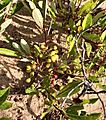Sand cherry facts for kids
Quick facts for kids Sand cherry |
|
|---|---|
 |
|
| Fruit in late July. | |
| Conservation status | |
| Scientific classification | |
| Synonyms | |
|
List
Prunus besseyi L.H.Bailey
Prunus cerasa Crantz Prunus cuneata Raf. Prunus floribunda K. Koch Prunus depressa hort Pursh Prunus prunella Daniels Prunus rosebudii Reagan Prunus susquehanae hort. ex Willd. Cerasus pumila (L.) Michx. Microcerasus pumila (L.) Eremin & Yushev Cerasus besseyi (L.H.Bailey) Smyth Cerasus depressa (Pursh) Ser. |
The sand cherry (scientific name: Prunus pumila) is a cool plant from North America. It's a type of cherry and belongs to the rose family. You can find it all over eastern and central Canada, from New Brunswick to Saskatchewan. It also grows in the northern United States, from Maine to Montana. Some sand cherries even pop up in Colorado, Kansas, Indiana, Virginia, Tennessee, and Utah.
Sand cherries love to grow in sandy places. This includes areas like lake shores and sand dunes.
Contents
What Does a Sand Cherry Look Like?
The sand cherry is a deciduous shrub. This means it loses its leaves every fall. It usually grows to be about 2 to 6 feet (60 to 180 cm) tall. The exact height depends on the specific type of sand cherry.
How It Grows
This plant often forms thick groups of plants that are all connected underground. These groups are called clonal colonies. They grow from sprouts that come up from the plant's root system.
Leaves, Flowers, and Fruit
The leaves of the sand cherry are strong and feel a bit leathery. They are about 4 to 7 centimeters (1.5 to 2.7 inches) long. The edges of the leaves have small teeth, which is called a serrated margin.
The flowers are pretty and white. Each flower is about 15 to 25 millimeters (0.6 to 1 inch) wide. They have five white petals and many stamens, which are the parts that make pollen. The flowers grow in small groups of two to four.
The fruit is a small cherry. It's usually about 13 to 15 millimeters (0.5 to 0.6 inches) across. These cherries turn a dark purple color when they are ripe. They are ready to eat in early summer.
Different Kinds of Sand Cherries
There are a few different types, or varieties, of sand cherries. Each one has a slightly different place where it likes to grow:
- Western sand cherry (Prunus pumila var. besseyi): This type is also called the Rocky Mountain cherry. You can find it in Saskatchewan, Manitoba, western Ontario, and south to Colorado and Kansas.
- Eastern sand cherry (Prunus pumila var. depressa): This variety grows in Ontario, Québec, New Brunswick, and south to Pennsylvania.
- Great Lakes sand cherry (Prunus pumila var. pumila): As its name suggests, this one grows along the shores of the Great Lakes.
- Susquehana sand cherry (Prunus pumila var. susquehanae): This type spreads from Manitoba east to Maine, and south to Tennessee.
A Special Hybrid Cherry
There's also a special plant called Prunus × cistena. It's known as the purple leaf sand cherry. This plant is a hybrid. A hybrid is a new plant created by crossing two different types of plants. Prunus × cistena is a mix of Prunus cerasifera (which is a cherry plum) and Prunus pumila (our sand cherry).
This hybrid was created by a scientist named Niels Ebbesen Hansen. He worked at South Dakota State University in 1910. These purple leaf sand cherries can grow to be about 7 feet (2.1 meters) tall. They can live for up to 20 years.
Gallery
Images for kids
See also
 In Spanish: Prunus pumila para niños
In Spanish: Prunus pumila para niños







